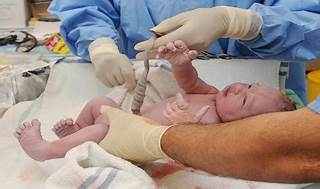A nurse is assisting in the care of a newborn immediately after birth. At 5 min after birth, the newborn has acrocyanosis, flexed extremities, a grimace when suctioned, a heart rate of 130/min, and a lusty cry with tactile stimulation. What should the nurse document as the newborn's 5-min Apgar score?
7
8
9
10.
The Correct Answer is A
Step 1 is assessing heart rate. A heart rate of 130/min earns 2 points since a rate above 100/min is optimal.
Step 2 is assessing respiratory effort. A lusty cry earns 2 points as strong crying indicates good respiratory function.
Step 3 is assessing muscle tone. Flexed extremities earn 1 point since full active movement would score 2.
Step 4 is assessing reflex irritability. Grimace when suctioned earns 1 point as a vigorous response (cough, sneeze) would score 2.
Step 5 is assessing color. Acrocyanosis earns 1 point since a fully pink body scores 2.
Final answer: 7
Nursing Test Bank
Naxlex Comprehensive Predictor Exams
Related Questions
Correct Answer is D
Explanation

The correct answer is choice d. Place the client in a knee-chest or Trendelenburg position.
Choice A rationale:
Preparing the client for an emergency cesarean birth is important, but it is not the immediate first action. The priority is to relieve pressure on the umbilical cord to prevent fetal hypoxia.
Choice B rationale:
Explaining to the client what is happening is important for communication and reassurance, but it is not the immediate first action. Immediate physical intervention is required to prevent harm to the fetus.
Choice C rationale:
Covering the cord with a sterile, moist saline dressing is a necessary step to prevent the cord from drying out and to reduce infection risk, but it should be done after repositioning the client to relieve pressure on the cord.
Choice D rationale:
Placing the client in a knee-chest or Trendelenburg position helps to relieve pressure on the umbilical cord, which is crucial to maintain fetal oxygenation. This is the immediate first action to take in this emergency situation.
Correct Answer is C
Explanation
Choice C rationale:
This response is correct because black stools are a common side effect of taking iron supplements. Iron can cause the stool to appear black or
tarry due to the way it is broken down during digestion. It does not necessarily indicate a serious issue, especially if the client is not experiencing any abdominal pain or cramping. Educating the client about this expected side effect helps alleviate any concerns they might have about the change in stool colour.
Choice A rationale:
"Go to the emergency room and your provider will meet you there.”. This response is not appropriate in this situation. The client's report of black stools without abdominal pain or cramping is likely due to the iron supplements and does not warrant a visit to the emergency room. This response may cause unnecessary panic and anxiety for the client.
Choice B rationale:
"What else have you been eating?.”. This response is also not the best choice. While it's essential for healthcare providers to gather comprehensive information about a client's diet and lifestyle, in this case, the client's black stools can be directly attributed to the iron supplements. Focusing on other dietary factors might distract from addressing the client's concern about the side effect of iron supplementation.
Choice D rationale:
"Come to the office, and we will check things out.”. This response is not the most appropriate one either. A visit to the office might not be necessary solely based on the client's report of black stools without accompanying pain or cramping. This situation can be managed through education, and the client can be reassured that it is a typical side effect of iron supplements. An unnecessary visit to the office could inconvenience the client and waste both their time and the healthcare provider's time.
Whether you are a student looking to ace your exams or a practicing nurse seeking to enhance your expertise , our nursing education contents will empower you with the confidence and competence to make a difference in the lives of patients and become a respected leader in the healthcare field.
Visit Naxlex, invest in your future and unlock endless possibilities with our unparalleled nursing education contents today
Report Wrong Answer on the Current Question
Do you disagree with the answer? If yes, what is your expected answer? Explain.
Kindly be descriptive with the issue you are facing.
